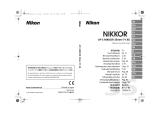
12
Jp
En
De
Fr
Es
Sv
Ru
Nl
It
Cz
Sk
Ro
Ua
Ck
Ch
Kr
For Your Safety
CAUTIONS
• Do not disassemble.
Touching the internal parts of the camera or lens
could result in injury.
In the event of malfunction, the product should
be repaired only by a qualified technician.
Should the product break
open as the result of a fall or other accident, remove the camera battery
and/or disconnect the AC adapter and then take the product to a
Nikon-authorized service center for inspection.
• Turn the camera off immediately in the event of malfunction.
Should you
notice smoke or an unusual smell coming from the equipment,
immediately unplug the AC adapter and remove the camera battery,
taking care to avoid burns.
Continued operation could result in fire or
injury.
After removing the battery, take the equipment to a Nikon-
authorized service center for inspection.
• Do not use in the presence of flammable gas.
Operating electronic
equipment in the presence of flammable gas could result in explosion
or fire.
• Do not look at the sun through the lens or the camera viewfinder.
Viewing the
sun or other bright light source through the lens or viewfinder could
cause permanent visual impairment.
• Keep out of reach of children.
Failure to observe this precaution could
result in injury.
• Observe the following precautions when handling the lens and camera:
-Keep the lens and camera dry.
Failure to observe this precaution
could result in fire or electric shock.
- Do not handle the lens or camera with wet hands.
Failure to observe
this precaution could result in electric shock.
- Keep the sun well out of the frame when shooting backlit subjects.
Sunlight focused into the camera when the sun is in or close to the
frame could cause a fire.
- If the lens will not be used for an extended period, attach the front
and rear lens caps and store the lens out of direct sunlight.
If left in
direct sunlight, the lens could focus the sun’s rays onto flammable
objects, causing fire.
• Do not carry tripods with a lens or camera attached.
You could trip or
accidentally strike others, resulting in injury.
• Do not leave the lens where it will be exposed to extremely high temperatures,
such as in an enclosed automobile or in direct sunlight.
Failure to observe this
precaution could adversely affect the lens’ internal parts, causing fire.








